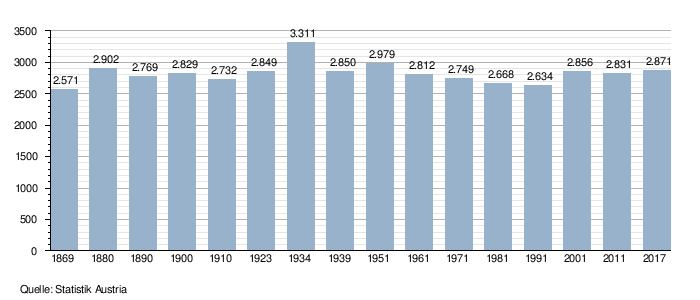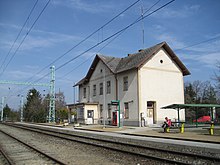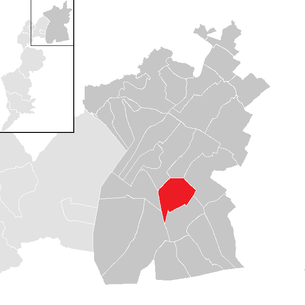Frauenkirchen
|
Borough Frauenkirchen
|
||
|---|---|---|
| coat of arms | Austria map | |
|
|
||
| Basic data | ||
| Country: | Austria | |
| State : | Burgenland | |
| Political District : | Neusiedl am See | |
| License plate : | ND | |
| Surface: | 31.93 km² | |
| Coordinates : | 47 ° 50 ' N , 16 ° 55' E | |
| Residents : | 2,856 (January 1, 2020) | |
| Population density : | 89 inhabitants per km² | |
| Postal code : | 7132 | |
| Community code : | 1 07 05 | |
| NUTS region | AT112 | |
| UN / LOCODE | AT FKN | |
| Address of the municipal administration: |
Amtshausgasse 5 7132 Frauenkirchen |
|
| Website: | ||
| politics | ||
| Mayor : | Josef Ziniel ( SPÖ ) | |
|
Municipal Council : ( 2017 ) (23 members) |
||
| Location of Frauenkirchen in the Neusiedl am See district | ||
 Frauenkirchen, basilica with Marian column and Franciscan monastery |
||
| Source: Municipal data from Statistics Austria | ||
Frauenkirchen is a town in the district of Neusiedl am See ( Burgenland ) with 2856 inhabitants (as of January 1, 2020), of which more than 7% belong to the Burgenland-Hungarians . The Hungarian place name of the city is Boldog-Asszony or Fertőboldog-Asszony .
history

The place was first mentioned in the Kingdom of Hungary as Szent Maria in 1324. In 1529 ( first siege of the Turks in Vienna ) and in 1683 ( second siege of the Turks in Vienna ) the village and the church were destroyed by the Ottomans. The reconstruction took place under the landlord Paul I. Esterhazy , one of the largest landowners in old Hungary.
Around the basilica and the Franciscan monastery, which was built between 1695 and 1702, the place, predominantly inhabited by German speakers, gradually developed into a regional trading center from the end of the 17th century. Frauenkirchen has been connected to the Austro-Hungarian railway network with the Neusiedler Seebahn since 1897 .
From 1898 had to because of the Magyarization of the government in Budapest used the Hungarian name Fertőboldogasszony or Boldogasszony (Fertő = Lake Neusiedl , Fertö = swamp).
After the end of the First World War , Frauenkirchen was awarded to Austria after tough negotiations like all of German-West Hungary in the treaties of St. Germain and Trianon in 1919 and 1920 respectively. The place has therefore been part of the newly founded Austrian state of Burgenland since 1921 (see also the history of Burgenland ). Frauenkirchen was raised to a municipality in 1982.
The prisoner-of-war cemetery in Frauenkirchen in Burgenland (also known as the Serbian cemetery ) contains graves of prisoners of war from the First World War . The prisoners of war came mainly from Serbia , Russia and Italy .
Jewish community of Frauenkirchen
In 1678 Count Paul I. Esterhazy allowed the Mönchhofer Jews , who had been attacked and plundered by hussars and expelled from the place by the abbot of Heiligenkreuz Abbey , to settle in Frauenkirchen. In 1876 the Jewish community in Frauenkirchen reached its peak with 864 Jews. This corresponded to about a third of the entire population. The place belonged to the seven Jewish communities in Burgenland.
After the " Anschluss of Austria " to National Socialist Germany in March 1938, a provisional detention camp was set up in Frauenkirchen , to which around 400 Jews from the Seewinkel were forcibly taken. In April 1938, most of these Jews were deported across the Hungarian border and the Jewish community was subsequently destroyed. The synagogue was demolished in 1939 and the Jewish cemetery has been preserved.
In 1938 there were around 350 Jews living in Frauenkirchen, a third of whom did not survive Nazi rule. Their houses were razed by the Nazis, reported the ORF Burgenland. On May 31, 2016, the memorial "Garden of Remembrance" was opened on the site of the former synagogue. You can see three panels with the surnames of the former Jewish families of Frauenkirchen, excavated remains of the synagogue wall and the sculpture of a Torah scroll .
Population development

Culture and sights
- The Frauenkirchen basilica makes the municipality a place of pilgrimage .
- The Franciscan monastery of Frauenkirchen is attached to the basilica to the north.
- A calvary as a building stands on the church square in the south of the basilica.
- Frauenkirchen Jewish cemetery
- Garden of Remembrance
- Frauenkirchen hopper
Economy and Infrastructure

Frauenkirchen is a school town with a primary and secondary school and a commercial academy. There are a few shops in the pedestrian zone. After drilling a rich thermal spring , the water law permit for the construction of a thermal bath was granted and in 2009 the St. Martins Therme & Lodge opened.
There is a medical center with an accident ambulance, a Red Cross rescue center with an emergency vehicle , a medical center, a nursing home, a day care center and a shared apartment.
Frauenkirchen is the starting point for the up to the integration into the St. James Austria in Haslau-Maria Ellend mostly running in Burgenland St. James Burgenland .
The project of a 14 hectare greenhouse for tomatoes in the community, for which the reallocation of land had already been approved, was supported by Governor Hans Niessl , but was opposed by a citizens' initiative with Erich Stekovics . The project was abandoned by the operator at the end of 2016.
politics
Municipal council
The council comprises a total of 23 members on the basis of population.
| Political party | 2017 | 2012 | 2007 | 2002 | 1997 | ||||||||||
|---|---|---|---|---|---|---|---|---|---|---|---|---|---|---|---|
| Sti. | % | M. | Sti. | % | M. | Sti. | % | M. | Sti. | % | M. | Sti. | % | M. | |
| SPÖ | 1006 | 51.09 | 12 | 1079 | 54.03 | 13 | 1158 | 57.58 | 14th | 1196 | 61.71 | 14th | 1,278 | 69.87 | 16 |
| ÖVP | 623 | 31.64 | 7th | 421 | 21.08 | 5 | 528 | 26.26 | 6th | 742 | 38.29 | 9 | 551 | 30.13 | 7th |
| FPÖ | 91 | 4.62 | 1 | not running | not running | not running | not running | ||||||||
| NLF | 249 | 12.65 | 3 | not running | not running | not running | not running | ||||||||
| Nest | not running | 497 | 24.89 | 5 | 325 | 16.16 | 3 | not running | not running | ||||||
| Eligible voters | 2743 | 2748 | 2673 | 2474 | 2326 | ||||||||||
| voter turnout | 77.76% | 80.57% | 84.25% | 86.42% | 88.61% | ||||||||||
Parish council
In addition to Mayor Josef Ziniel (SPÖ) and Deputy Mayor Matthias Jakob Doser (SPÖ), the councilors Karin Hild (LNF), Martina Kettner (ÖVP), Franz Lass (ÖVP), René Rommer (SPÖ) and Stefan Würtz (SPÖ) also belong to the municipal board on.
mayor
Mayor is Josef Ziniel (SPÖ), who succeeded Hans Niessl (SPÖ) after his election as governor in 2000 . In the direct mayor election 2017 he prevailed with 52.40% over his competitors Franz Lass (ÖVP, 35.40%) and Karin Hild (NLF, 12.20%).
Deputy Mayor is Matthias Jakob Doser (SPÖ).
Head of office is Erika Siebler.
Chronicle of the mayor
| from | to | mayor | Party, note |
|---|---|---|---|
| 1919 | Franz Nießl | Municipal administration commissioner | |
| 1922 | Michael Stifter | Municipal administration commissioner | |
| 1922 | Franz Nießl | Municipal administration commissioner | |
| 1923 | Stefan Kettner | Municipal administration commissioner | |
| 1923 | 1927 | Johann Kobor | |
| 1927 | 1929 | Josef Reiner | SDAPDÖ |
| 1929 | 1931 | Johann Kobor | |
| 1931 | 1934 | Paul Lagler | SDAPDÖ |
| 1934 | 1938 | Martin Wetschka | Municipal administration commissioner, VF |
| 1938 | Johann Birschitzky | NSDAP | |
| 1938 | 1945 | Tibor Püspök | NSDAP |
| 1945 | 1954 | Martin Wetschka | ÖVP |
| 1954 | 1958 | Johann Kobor | |
| 1958 | Franz Nießl | SPÖ | |
| 1958 | 1972 | Johann Kiss | SPÖ |
| 1972 | 1974 | Martin Wetschka jun. | ÖVP |
| 1974 | 1976 | Johann Würz | SPÖ |
| 1976 | 1987 | Jacob couple | SPÖ |
| 1987 | 2000 | Hans Niessl | SPÖ |
| since 2000 | Josef Ziniel | SPÖ | |
Personalities
- Hans Niessl , Governor of Burgenland (2000–2019), was mayor of Frauenkirchen.
- Mayor Johann Kobor (1882–1958) ran an inn and a cinema in Frauenkirchen.
- The politicians Stefan Kettner (1887–1957) and Martin Wetschka (1888–1971) were born in Frauenkirchen .
- With his cultivation of over 3200 different varieties of tomatoes, Erich Stekovics is considered the "Kaiser of the tomatoes".
- Josef Umathum achieved national recognition with his winery .
- Isabelle Zwinger is national champion in vaulting.
- Markus Bruck is national champion over several long distances. (To run)
- Jonas Reiner is national champion over 60 meter hurdles. (Hall)
- Frauenkirchen is the birthplace of the composer Mihály Mosonyi (German: Michael Brand, 1815-1870).
- The painter and nun Elfriede Ettl (1914–2003) was born in Frauenkirchen.
gallery
literature
- Michaela Irene Bauer: settlement and local history of Frauenkirchen. Dissertation, University of Vienna 1982.
- Sepp and Paul Gmasz: Chronicle Stadtgemeinde Frauenkirchen. Frauenkirchen 1988.
- Rudolf Schneider (partial author and editor): “Chronicle II, 25 years of the Frauenkirchen municipality” Frauenkirchen 2007.
- Herbert Brettl: The Jewish community of Frauenkirchen. Ed. Lex Liszt 12, Oberwart 2003, ISBN 3-901757-32-5 .
- Erika Brunner-Hammerl: The pilgrimage church and the calvary of Frauenkirchen. Diploma thesis, University of Vienna 2007.
- Section “The partner communities” in “TÜPL Bruckneudorf - 150 Years of Brucker Lager” by Petra Weiß, publisher. Stadtgemeinde Bruck an der Leitha, April 2017, p. 426/427
Web links
- 10705 - Frauenkirchen. Community data, Statistics Austria .
- Storm in June 1995 - Radio report from Frauenkirchen in the online archive of the Austrian Media Library (Ö1-Mittagsjournal)
Individual evidence
- ↑ Barbara Coudenhove-Calergi : Paul Rosenfeld - One came back. In: Süddeutsche Zeitung , Austrian Jewish Museum , 14./15. June 1986.
- ↑ http://burgenland.orf.at/news/stories/2777327/ Memorial for the Jews of Frauenkirchen, orf.at May 31, 2016, accessed May 31, 2016.
- ↑ From for glass house project in Frauenkirchen orf.at, December 31, 2016, accessed December 31, 2016.
- ↑ a b Province of Burgenland: Frauenkirchen 2017 election results (accessed on December 2, 2017)
- ↑ Province of Burgenland: election results Frauenkirchen 2012 (accessed on December 2, 2017)
- ↑ Province of Burgenland: Frauenkirchen 2007 election results (accessed on December 2, 2017)
- ↑ a b Province of Burgenland: Frauenkirchen 2002 election results (accessed on December 2, 2017)
- ↑ Stadtgemeinde Frauenkirchen: Community Board (accessed on December 2, 2017)
- ↑ Stadtgemeinde Frauenkirchen: Mayor (accessed on December 2, 2017)
- ↑ Stadtgemeinde Frauenkirchen: Vice Mayor (accessed on December 2, 2017)
- ↑ Stadtgemeinde Frauenkirchen: Staff (accessed on December 2, 2017)
- ↑ Mag Sepp Gmasz and Paul Gmasz. Chronicle township Frauenkirchen . Ed .: Stadtgemeinde Frauenkirchen, 7132 Frauenkirchen, Amtshausgasse 7. Frauenkirchen 1982, p. 168 .
- ↑ a b c Mag. Phil. Matthias Lidy: The Frauenkirchen detention camp in its role for the National Socialist takeover in the Neusiedl am See district . Ed .: Diploma thesis University of Vienna. Vienna October 2014, p. 133 .
- ↑ Sebastian Herrmann : Tomato grower. The emperor of the tomatoes. In: Süddeutsche Zeitung , August 14, 2007 (and as a PDF file, 7 p. ( Memento of the original from June 16, 2015 in the Internet Archive ) Info: The archive link was inserted automatically and has not yet been checked. Please check the original and archive link according to the instructions and then remove this notice. ).








